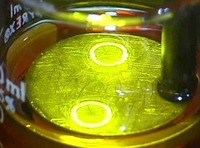 You don’t have enough cash on hand to buy that USD$40,000 Laser Sintering unit, but you are really curious about the process. No trouble – just do the experiment at home!
You don’t have enough cash on hand to buy that USD$40,000 Laser Sintering unit, but you are really curious about the process. No trouble – just do the experiment at home!The University of Wisconsin has posted the procedure for a lithography experiment you might even attempt at home, providing you have sufficient chemicals, a front-projector and of course, rubber gloves:
In this lithography experiment light creates free radicals from phenylbis(2,4,6-trimethylbenzoyl)phosphine oxide which induce polymerization of 1,6-hexanediol diacrylate. Light is supplied by a computer projector which shines the pattern for one layer at a time. After each layer, the elevator is slightly lowered and the process is repeated. A dye (Sudan I) is included to prevent light from penentrating much below the surface of the solution.
Here’s the materials list for the experiment:
- 1,6-Hexanediol diacrylate (Aldrich 246816)
- Sudan I (Aldrich 103624)
- Phenylbis(2,4,6-trimethylbenzoyl)phosphine oxide (Aldrich 511447)
- Computer with Powerpoint
- Projector
- Magnifying glass
- Mirror
- Platform elevator
This is a very simple approach using more or less common items. We’re wondering if this could be the basis for a low-cost hobbyist sintering kit?

